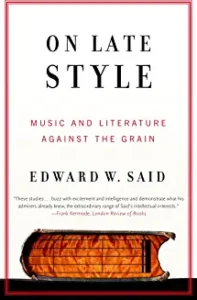On Late Style by Edward W. Said 2006
I have long been intrigued by Said, a Palestinian-American who was involved politically with trying to establish a Palestinian state while simultaneously writing, teaching, and lecturing as a leading cultural critic, philosopher, historian, and classical pianist. When I spied this book on a shelf at a used book store in Cambridge, I was finally able to read this distinguished scholar of Orientalism, literature, and music.
Not an easy read by any measure. Said formulates a theory of ‘lateness’, not necessarily the final works of authors and composers (as did Harold Bloom in his book of last poems, ‘How I End my Song’) or about how they dealt with their imminent deaths (as did Katie Roiphe in ‘The Violet Hour’), but rather how their work was affected by aging, physical frailty, and ultimately, their approaching death. His scholarship is extensive and impressive. His insights are intriguing but his writing is incredibly dense, and I found it difficult to wade through. This is my shortcoming, not his, but passages such as the following, often left me a bit at sea: “Adorno exemplifies the European intellectual who refused to compromise the the culture industry as he saw it. His characteristic anti-identitarian notion is that of antinomian opposition, unresolved contradictions that he believed he existed to maintain, insist on, and gloss in a prose that—whether in German of in the various translations that have been made of it—remains permanently, fanatically difficult. As I also said, Adorno is lateness itself, hell-bent on remaining untimely and contrary in the Neitzschean sense.” And he says Adorno is ‘difficult’!
Through analysis and commentary on Adorno, Beethoven’s later string quartets and Missa Solemnis, Mozart’s Cosi Fan Tutte, Glenn Gould’s The Goldberg Variations, Lampedusa’s ‘The Leopard’, Mann’s novella and Britten’s opera ‘Death in Venice’, Jean Genet’s autobiography, and Cavafy’s poetry, Said advances his theory that ‘late’ works are a way of remembering time as the artist, unreconciled to infirmities of the present and unwilling to adopt the palliatives of the past, seeks out the future through a new process of self-making. The result is a new style, against the grain of the current culture, that sets the stage for the next period of progress, or in Gould’s case, a new interpretation of the past.
This was not an easy read and I’m sure that my understanding of Said’s thesis remains relatively shallow and superficial, but it was a fine introduction to a deep thinker with an awe-inspiring intellectual wing-span and who remains an important cultural influence in the 21st century.



